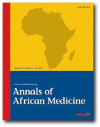
|
Annals of African Medicine
Annals of African Medicine Society
ISSN: 1596-3519
Vol. 7, No. 2, 2008, pp. 77-81
|
 Bioline Code: am08017
Bioline Code: am08017
Full paper language: English
Document type: Research Article
Document available free of charge
|
|
|
Annals of African Medicine, Vol. 7, No. 2, 2008, pp. 77-81
| en |
Description of the Normal Variants of the Anatomical Shapes of the Sella Turcica Using Plain Radiographs: Experience from Sokoto, Northwestern Nigeria
Zagga, A. D.; Ahmed, H.; Tadros, A. A. & Saidu, S. A.
Abstract
Background:
The anatomy of the sella turcica is variable in size and shape. It has been classified into three types: round, oval and flat. It can also be deep or shallow in both children and adults. The floor of the sella turcica which in most cases is concave may be, flat or even convex. In both anatomical and radiological practice in Nigeria, normal data in relation to the description of the normal variants of the anatomical shapes of the sella turcica are based on Caucasian studies.
Methods:
All available lateral skull radiographs of subjects over a 3-year period, from 2002 to 2004, were retrieved from the Radiology Department of the Usmanu Danfodiyo University Teaching Hospital, Sokoto for the study. Radiographs were mounted on the viewing boxes and sellae turcicae were studied and classified.
Results:
A total of 228 subjects were involved in this study. Of this figure, 171 (75%) were males, and 57 (25%) were females (m: f ratio = 3:1). The predominant shape of sella in the African subjects studied is oval, and the difference in frequency of oval shaped sella and that of round or flat types is highly statistically significant. (P<.001).The commonest type of sella floor in the African subjects studied is concave and the difference in frequency of concave shaped sella floor and that of flat and convex types is highly statistically significant.(P<.001). In both the various anatomical shapes of the sella turcica and the types of floor of the sella turcica in relation to sex of the subjects studied, the difference in frequency of males and females is highly statistically significant. (P<.001).
Conclusion:
It is concluded that the prevalence and the relative frequencies of the normal variants of the anatomical shapes of the sella turcica reported in this study on Nigerian subjects is similar to those reported in Caucasians. Further studies on a larger scale are needed to corroborate our findings.
Keywords
Description, normal variants, anatomical shapes, sella turcica
|
| |
| fr |
Zagga, A. D.; Ahmed, H.; Tadros, A. A. & Saidu, S. A.
Résumé
Arrière Plan:
L’anatomie de sella turcica varie selon la forme et la plat. Elle peut aussi être profonol ou plat, aussi chez les enfants que chez les adults. Le planche de sella turcica, qui est généralement concave peut être convexe, ou plat de forme. Bien en anatomie et en radiologie practiques au Nigéria. Les données relatives à la description des variants normales de formes anatomiques de sella turcica sont basées sur des études caucasiennes.
Méthodes:
Toutes les radiographes laterales du été collectées du departement de 3 ans (2002 a 2004) ont été collectées du departement de Radiologie de centre uiversitaire hospitalier de université Usmanu Danfodiyo pour cette étude. Les radiographes ont été montées sur les boîtes de visualization et sella turcica ont étés étudiées et classifiées.
Resultats:
Un total de 228 sujets ont été impliqués dans cette étude. De ce total, 171 (75%) étaient males, et 57 (25%) étaient femelles (m: f ratio = 3:1). La forme predominante de sella turcica pour les sujets africains étudiés est ovale, et la différence en frequence entre sella à forme ovale et sella à forme ronde ou plate est statistiquement très élevée. (PL 0.001).
Le plancher de sella de plus commun pour les sujets africains étudiés est concave et la différence en frequence entre sella a plancher cancave sella à plancher convexe is statistiquement ties élevée. (PL 0.001).pour les deux cas de formes plancher de sella turcica et les différents types de plancher de sella turcica, en ce qui est du sex des sujets étudiés, la différence en frequence entre les mâles et les femelles est statistiquement très élevée. (PL 0.001).
Conclusion:
Il est concluque la predominance et relativité des frequences de variantes normales de formes anatomiques de sella turcica considérées dans cette étude surdes sujets Nigérians est similaire à celle considérées pour les "caucasians". Des études plus poussées sur un champ plus étendu sont nécessaires pour confirmer nos decouvertes.
Mots Clés
Description, variantes normales, formes anatomiques, sella turcica
|
| |
© Copyright 2008 - Annals of African Medicine
Alternative site location: http://www.annalsafrmed.org
|
|
